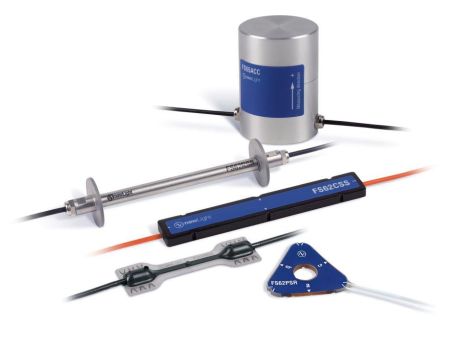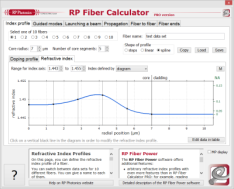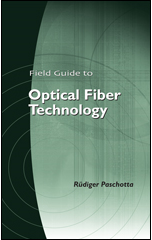Fiber-optic Sensors
Definition: optical sensors based on fiber devices
Alternative term: fiber sensors
German: faseroptische Sensoren
Categories: fiber optics and waveguides, photonic devices
How to cite the article; suggest additional literature
Author: Dr. Rüdiger Paschotta
Fiber-optic sensors (also called optical fiber sensors) are fiber-based optical sensors for some quantity, typically temperature or mechanical strain, but sometimes also displacements, vibrations, pressure, acceleration, rotations (measured with optical gyroscopes based on the Sagnac effect), or concentrations of chemical species. The general principle of such devices is that light from a laser (often a single-frequency fiber laser) or from a superluminescent source is sent through an optical fiber, experiences subtle changes of its parameters either in the fiber or in one or several fiber Bragg gratings, and then reaches a detector arrangement which measures these changes.
One distinguishes intrinsic and extrinsic sensors. Intrinsic sensors are those where a fiber itself (possibly in a modified form, e.g. containing a Bragg grating) acts as the sensor. Extrinsic sensors use fibers only for transporting light to and from the actual sensor.
Many fiber-optic sensors are based on single fibers, but others are made with fiber bundles. For example, there are extrinsic sensors where some illumination light is sent to a sample through some of the fibers of a bundle, and reflected light or into used fluorescence light is sent back through other fibers.
Compared with other types of sensors, fiber-optic sensors exhibit a number of advantages:
- They consist of electrically insulating materials (no electric cables are required), which makes possible their use e.g. in high-voltage environments.
- They can be safely used in explosive environments, because there is no risk of electrical sparks, even in the case of defects.
- They are immune to electromagnetic interference (EMI), even to nearby lightning strikes, and do not themselves electrically disturb other devices.
- Their materials can be chemically passive, i.e., do not contaminate their surroundings and are not subject to corrosion.
- They have a very wide operating temperature range (much wider than is possible for many electronic devices).
- They have multiplexing capabilities: multiple sensors in a single fiber line can be interrogated with a single optical source (see below).
Bragg Grating Sensors
Fiber-optic sensors are often based on fiber Bragg gratings. The basic principle of many fiber-optic sensors is that the Bragg wavelength (i.e., the wavelength of maximum reflectance) of a fiber Bragg grating depends not only on the Bragg grating period but also on temperature and mechanical strain.
For optical strain sensors based on silica fibers, the fractional response of the Bragg wavelength to strain is roughly 20% smaller than the strain itself, since the direct effect of strain is to some extent reduced by a decrease in refractive index. The temperature effect is close to that expected from thermal expansion alone. The effects of strain and temperature can be distinguished with various techniques (e.g. by using reference gratings which are not subject to the strain, or by combining different types of fiber gratings), so that both quantities are obtained at the same time.
For pure strain sensing, the resolution can be the range of a few με (i.e., relative length changes of a few times 10−6), and the accuracy may not be much lower. For dynamic measurements (e.g. of acoustic phenomena), sensitivities better than 1 nε in a 1-Hz bandwidth are achievable.
There are also Bragg grating laser sensors, where fiber lasers are realized, consisting of two gratings and a rare-earth doped fiber in between. Alternatively, there can be one FBG and a broadband reflector on the other side. When supplied with pump light, such a device produces an output with a wavelength close to the Bragg wavelength.
Quasi-distributed Sensing
A single fiber may contain many grating sensors (see above) in series to monitor the temperature and strain distribution along the whole fiber. This is called quasi-distributed sensing. There are different techniques to address the single gratings (and thus certain locations along the fiber):
- In one technique, called wavelength division multiplexing (WDM) or optical frequency-domain reflectometry (OFDR), the gratings have slightly different Bragg wavelengths. A wavelength-tunable laser in the interrogator unit can be tuned to the wavelength belonging to a particular grating, and the wavelength of maximum reflectance indicates the influences of strain or temperature, for example. Alternatively, a broadband light source (e.g. a superluminescent source) may be used together with a wavelength-swept photodetector (e.g. based on a fiber Fabry–Pérot) or a CCD-based spectrometer. In any case, the maximum number of gratings is typically between 10 and 50, limited by the tuning range or bandwidth of the light source and the required wavelength interval per fiber grating.
- Another technique, called time division multiplexing (TDM), uses identical weakly reflecting gratings, interrogated with short light pulses. The reflections from different gratings are then distinguished via their arrival times. Time division multiplexing is often combined with wavelength division multiplexing in order to multiply the number of different channels to hundreds or even thousands.
- An optical switch allows one to select between different fiber lines, further multiplying the possible number of sensors.
Distributed Sensing
Other fiber-optic sensors do not use fiber Bragg gratings as sensors, but rather the fiber itself. The principle of sensing can then be based on Rayleigh scattering, Raman scattering or Brillouin scattering. For example, optical time domain reflectometry is a method where weak reflections can be localized using a pulsed probe signal. It is also possible, e.g., to exploit the temperature or strain dependence of the Brillouin frequency shift.
In some cases, the measured quantity is a kind of average over the full fiber length. This is the case for certain temperature sensors but also for Sagnac interferometers used as gyroscopes. In other cases, position-dependent quantities (e.g. temperatures or strains) are measured. This is called distributed sensing.
See the articles on optical temperature sensors and optical strain sensors for more details.
Other Approaches
Apart from the approaches described above, there are many alternative techniques. Some examples are:
- Fiber Bragg gratings may be used in interferometric fiber sensors, where they merely serve as reflectors, and the measured phase shift results from fiber spans between them.
- There are Bragg grating laser sensors, where a sensor grating forms the end mirror of a fiber laser resonator, containing e.g. some erbium-doped fiber, which receives some 980-nm pump light via the fiber line. The Bragg wavelength, which depends on e.g. temperature or strain, determines the lasing wavelength. This approach, which has many further variations, promises very high resolution due to the small linewidth of such a fiber laser, and very high sensitivity.
- In some cases, pairs of Bragg gratings are used as fiber Fabry–Pérot interferometers, which can react particularly sensitively to external influences. The Fabry–Pérot interferometer can also be made with other means, e.g. with a variable air gap in the fiber.
- Long-period fiber gratings are particularly interesting for multi-parameter sensing (e.g. of temperature and strain), and alternatively for strain sensing with very low sensitivity to temperature changes.
Applications
Even after a number of years of development, fiber-optic sensors have still not enjoyed great commercial success, since it is difficult to replace already well-established technologies, even if they exhibit certain limitations. For some application areas, however, fiber-optic sensors are increasingly recognized as a technology with very interesting possibilities. This holds particularly for harsh environments, such as sensing in high-voltage and high-power machinery, or in microwave ovens. Bragg grating sensors can also be used to monitor the conditions e.g. within the wings of airplanes, in wind turbines, bridges, large dams, oil wells and pipelines. Buildings with integrated fiber-optic sensors are sometimes called “smart structures”; they allow one to monitor the inside conditions and to gain important information on the strain to which different parts of the structure are subject, on aging phenomena, vibrations, etc. Smart structures are a main driver for the further development of fiber-optic sensors.
Suppliers
The RP Photonics Buyer's Guide contains 54 suppliers for fiber-optic sensors. Among them:


HBM FiberSensing
The newly developed optical sensor line newLight enables large strain measurement ranges at increased long-term stability. It is the ideal choice for structural health monitoring due to its fast and easy installation and its resistance to environmental conditions such as humidity, rust, and salt even over extremely long distances.
The compatibility with standard telecom cables makes this line very cost efficient – especially for medium-to-high channel applications. The newLight range is based on the Fiber Bragg Grating technology and offers optical sensors for measurements of strain, temperature, accelerometer, and tilt.
In addition to fiber optical sensors that measure strain, temperature, acceleration, tilt or displacement, HBM also offers optical interrogators, software, as well as service and support for every application.


Technica Optical Components
Premium quality fiber Bragg grating sensors and FBG array sensors in acrylate, polyimide, and gold coated fibers, specialized polyimide-coated sensors to 300 °C, high-T FBG sensors to 1,000 °C, radiation hard/proof sensors, bio-chem tilted FBG sensors and ultra-thin FBG sensors and arrays. We produce GFRP FBG cable sensors for embedding into concrete and other materials, Zeus PEEK FBG cable sensors for monitoring in transformers and chemically active environments, and vibration-sensitive cable sensors for security.


NKT Photonics
With the LIOS Sensing product line, NKT Photonics is the market leader in distributed optical sensing of temperature and strain for security, safety and fire detection. Backed by more than 20 years of experience and thousands of systems in the field worldwide, we deliver LIOS monitoring solutions with unrivaled quality and performance. Our LIOS distributed temperature and strain sensing solutions give you a quick and easy overview of the status of your installation. We use passive optical fibers as distributed sensors, they are immune to vibration, electromagnetic noise, dust, cryogenic temperatures, and moisture. You get continuous and accurate monitoring of temperature and strain over long distances or across large surfaces – at the speed of light! It is highly reliable too, offering you a Mean Time Between Failure of above 45 years.
Questions and Comments from Users
Here you can submit questions and comments. As far as they get accepted by the author, they will appear above this paragraph together with the author’s answer. The author will decide on acceptance based on certain criteria. Essentially, the issue must be of sufficiently broad interest.
Please do not enter personal data here; we would otherwise delete it soon. (See also our privacy declaration.) If you wish to receive personal feedback or consultancy from the author, please contact him e.g. via e-mail.
By submitting the information, you give your consent to the potential publication of your inputs on our website according to our rules. (If you later retract your consent, we will delete those inputs.) As your inputs are first reviewed by the author, they may be published with some delay.
Bibliography
| [1] | D. Culverhouse et al., “Potential of stimulated Brillouin scattering as sensing mechanism for distributed temperature sensor”, Electron. Lett. 25, 913 (1989), doi:10.1049/el:19890612 |
| [2] | A. D. Kersey, “A review on recent developments in fiber optic sensor technology”, Opt. Fiber Technol. 2, 291 (1996), doi:10.1006/ofte.1996.0036 |
| [3] | A. D. Kersey et al., “Fiber grating sensors”, IEEE J. Lightwave Technol. 15 (8), 1442 (1997), doi:10.1109/50.618377 |
| [4] | B. Lee, “Review of the present status of optical fiber sensors”, Opt. Fiber Technol. 9 (2), 57 (2003), doi:10.1016/S1068-5200(02)00527-8 |
| [5] | L. Zou et al., “Coherent probe-pump-based Brillouin sensor for centimeter-crack detection”, Opt. Lett. 30 (4), 370 (2005), doi:10.1364/OL.30.000370 |
| [6] | F. M. Cox et al., “Opening up optical fibres”, Opt. Express 15 (19), 11843 (2007), doi:10.1364/OE.15.011843 |
| [7] | O. Franzão et al., “Optical sensing with photonic crystal fibers”, Laser & Photon. Rev. 2 (6), 449 (2008), doi:10.1002/lpor.200810034 |
| [8] | J. Albert et al., “Tilted Bragg grating sensors”, Laser & Photon. Rev. 7 (1), 83 (2013), doi:10.1002/lpor.201100039 |
| [9] | P. Roriz et al., “Review of fiber-optic pressure sensors for biomedical and biomechanical applications”, J. Biomed. Opt. 18 (5), 050903 (2013), doi:10.1117/1.JBO.18.5.050903 |
| [10] | L. Mescia and F. Prudenzano, “Advances on optical fiber sensors”, Fibers 2 (1), 1 (2014), doi:10.3390/fib2010001 |
See also: optical sensors, fibers, fiber Bragg gratings, optical strain sensors, optical temperature sensors, single-frequency lasers, laser applications
and other articles in the categories fiber optics and waveguides, photonic devices
 |







If you like this page, please share the link with your friends and colleagues, e.g. via social media:
These sharing buttons are implemented in a privacy-friendly way!